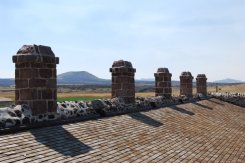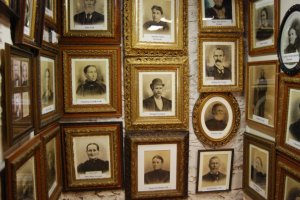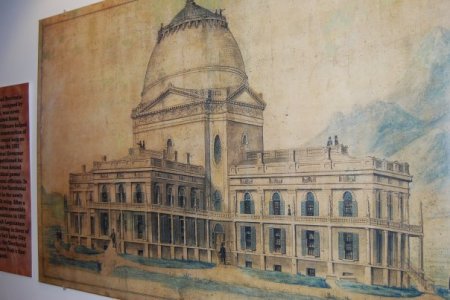2013 Gratitude Project – Travel: Fillmore and Cove Fort
This month will be a celebration of travel. I am so grateful for the many opportunities I’ve had over my nearly thirty years to explore the world. Click here to read about my 2013 November Gratitude Project – Travel
Two other adventures I made as a reporter for the Daily Universe were to Fillmore, Utah, the former territorial capitol, and to Cove Fort, a frontier fort built to protect settlers and travelers during the Black Hawk War.
Cove Fort
 Found in pretty much the middle of nowhere Utah and just a short distance off Interstate-15, this beautifully preserved piece of history is owned and operated by The Church of Jesus Christ of Latter-day Saints, members of which built the fort in 1867. Senior missionaries interpret the fort telling the story of the frontier Utah Territory and its settlers.
Found in pretty much the middle of nowhere Utah and just a short distance off Interstate-15, this beautifully preserved piece of history is owned and operated by The Church of Jesus Christ of Latter-day Saints, members of which built the fort in 1867. Senior missionaries interpret the fort telling the story of the frontier Utah Territory and its settlers.
The fort is very well kept with many original furnishings. However, other than the stories unique to the fort, the shtick is pretty much the same as any other pioneer-era historic site. They tell you about “sleep tight, don’t let the bedbugs bite” and all of the other little things about that age as if people who visit such sites aren’t already familiar with these anecdotes.
I found the architecture very fascinating. The structure itself was very similar to other Mormon forts like that at Pipe Springs National Monument being larger to serve a community as opposed to a single family. What was truly cool about the architecture was its material – it is made out of volcanic stone gathered from the region. With the storms being dark and the mortar nearly white, the building is quite cool looking. Also impressive is how thick the walls are – I don’t remember the dimensions, but they are pretty thick.



The fort isn’t the only thing to see at Cove Fort. They also have a cowboy’s bunk house, barn, blacksmith shop, garden and another historic home moved from Northern Utah. During one weekend each year, there is a festival with games, entertainment and crafts, sort of like a mild mountain man rendezvous for families.
Fillmore
 The county seat of Millard County is right in the center of the old Utah Territory, as many capitols were founded in the past. It was named after the president of the time and was supposed to seat the territorial government. However, Salt Lake City was the major city in the region where the government had been since colonizing and where the major power and influence was.
The county seat of Millard County is right in the center of the old Utah Territory, as many capitols were founded in the past. It was named after the president of the time and was supposed to seat the territorial government. However, Salt Lake City was the major city in the region where the government had been since colonizing and where the major power and influence was.
Since Fillmore was supposed to be the capitol a grand capitol building was designed by Utah’s greatest architect Truman Angel who designed the Salt Lake Temple, Beehive and Lion Houses, St. George Temple and many private homes and buildings. The renderings of the building are beautiful with a magnificent rotunda and four wings.
Unfortunately, only one of the wings was constructed leaving Utah without this magnificent edifice. That wing is now a state park and visitors can learn this small part of Utah history, which is fascinating.
 There are three stories. The basement houses a lot of the museum with tons of historic photographs and other artifacts. I think there is a printing press, old jail cell and other antiquities.
There are three stories. The basement houses a lot of the museum with tons of historic photographs and other artifacts. I think there is a printing press, old jail cell and other antiquities.
The main level is divided into many rooms that were offices and sitting rooms. The territorial legislature only met in the building for one session before the seat of government moved back to Salt Lake City. After that the building was used for a school and community center. The rooms on the main floor were classrooms.
One interesting story from Fillmore: most of the teachers at this school were non-Mormons come to Utah to teach the kids how wrong they were, their parents were and their church was. Back then it public schooling wasn’t really a big thing, so kids didn’t all go to school. However, to be good neighbors, the Mormons sent their kids to these teachers knowing they were trying to indoctrinate them. However, the parents just made sure they taught their kids at home about their values, principles and faith so they would be strong enough to think for themselves about what their teachers taught them.
The upper floor of the building is one big open space. This is where the legislature met. It is also where community meetings and social events took place.

What was built isn’t what Angell had intended, but it is a brilliant piece of history and a fantastic part of Utah’s story, which during the first several decades of settlement was a constant fight between the locals who made the desert blossom as a rose and outsiders who discriminated against them because of their faith and tried to dictate how things should be in the territory and eventually state.
I enjoyed these sites. Each offered a unique view into Utah’s past. I am grateful for places like this that are preserved to tell us the story of things gone by. I am also grateful for the lessons we can learn from these stories and the places used to tell them.



